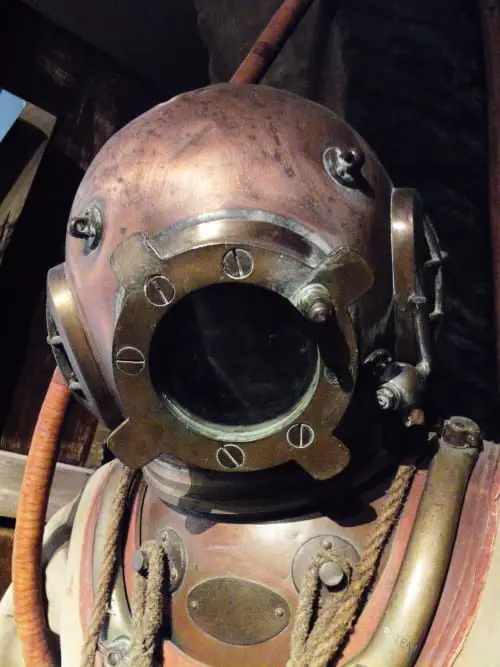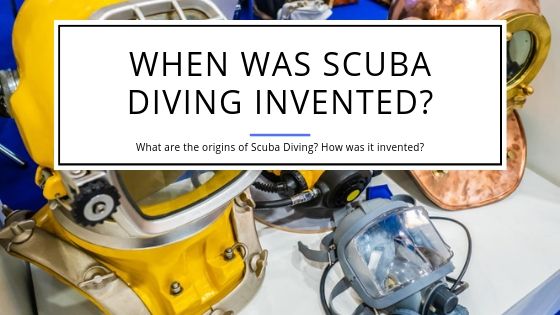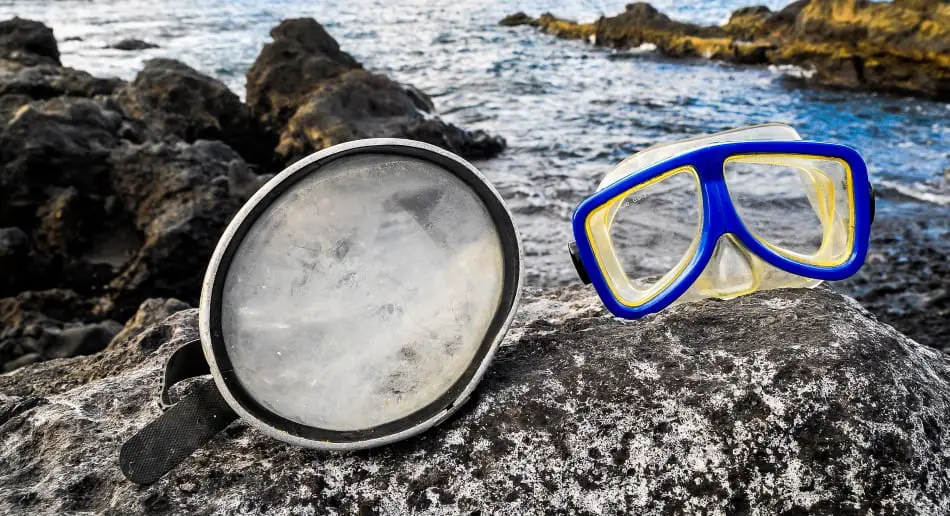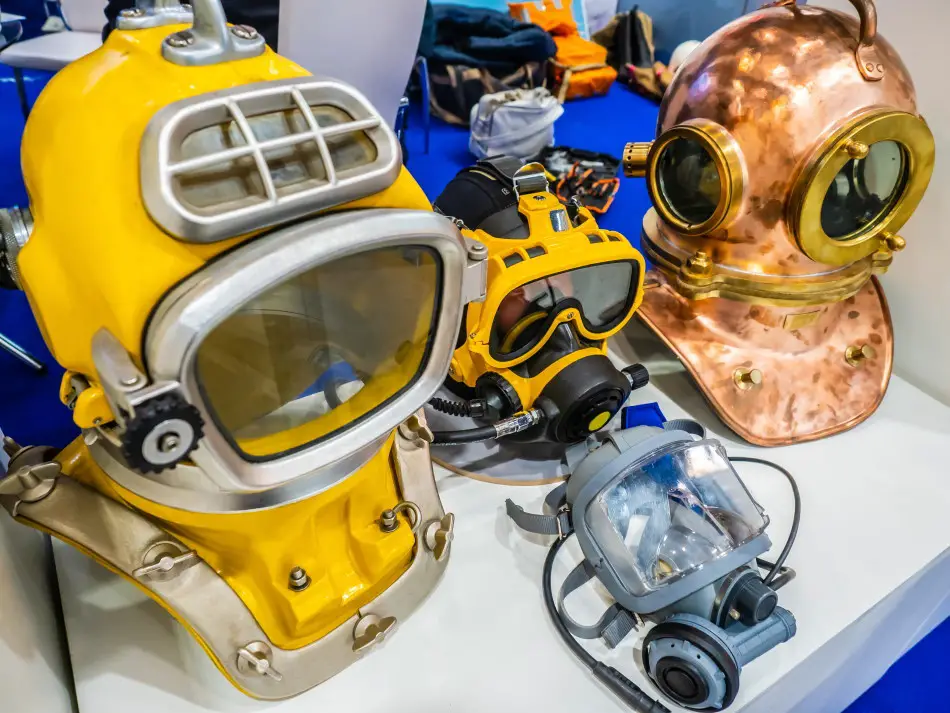Scuba Diving History – Timeline and Figures that invented modern Scuba!
In scuba diving, one breathes underwater and explores a whole new world. Discovering its thrills can be a life-changing experience for some. Its history goes way back, centuries back in fact.
In ancient times, simple resources that were used for breathing underwater were neither very safe nor extremely effective. In reality, it took decades before the modern scuba techniques were developed.
Here is a brief look at some important highlights in the history of scuba. Let’s have a look at who invented scuba and have a closer look at the history of scuba diving!
Was There Scuba Diving In Ancient Times?
Yes, scuba diving was present in ancient times. As we all know, scuba diving today is largely attributed to Jacques-Yves Cousteau and Emile Gagnan but its history goes back to the Greeks and Aristotle.
Ancient Greek Diving
Aristotle wrote in his work that Greek sponge divers made use of a bell filled with air that was lowered down to them to the bottom of the Mediterranean when they picked sponges off of there.
However, the air limitations restricted their movement and the amount of time they could stay underwater. During a few dives in 332 BCE, Alexander the Great has also been known to use a crude diving bell.
Diving a few Hundred Years in the Past
In 1772, Sieur Freminet developed self-contained air equipment for the first time which somewhat resembles today’s scuba set. The air inside the diving bell could be recycled through his scuba apparatus. However, after spending only 20 minutes underwater in his new invention, Freminet passed away because of lack of oxygen.
A different type of self-contained air device was then developed by William James in 1852. The device contained an iron belt that was attached to a copper helmet. This apparatus held air that was sufficient to accomplish a dive of a total of 7 minutes.
Modern Scuba Diving
Around a century later, in 1939, Christian Lambertsen also developed a self-contained underwater oxygen-breathing apparatus. His invention was specially made for the U.S. military. Although his device was a success in shallow waters, the high levels of oxygen toxicity that were created by it made the apparatus unsafe to be used in deep bodies of water.
When Was Modern Scuba Diving Invented?
All of the above inventions bring us to Cousteau’s and Gagnan’s contributions to the scuba world. Modern scuba diving was co-invented by the two brilliant Frenchmen and their invention opened doors for anyone interested in diving underwater. Jacques-Yves Cousteau concluded that for self-contained breathing apparatuses, compressed air that was further purified and filtered was the optimum gas mixture.
During World War II (between 1942 and 1943), Jacques-Yves Cousteau and Emile Gagnan made alterations to a pressure regulator created by Gagnan originally to overcome the shortage of resources, such as petroleum, caused during the war and allow transport vehicles to run on vegetable oil.
After the necessary adjustments, Gagnan’s regulator was capable of sending air at the required pressure. The pair then formulated the Aqua-Lung apparatus which was the main stepping stone for the creation of today’s scuba diving gear. The creation of Aqua-Lung will be discussed in detail later in this blog post.
When Did Regulators Become Part of Scuba Diving?
Regulators have been a part of scuba diving for ages. In a diving regulator, a demand valve is a mechanism that is used to control a gas supply to provide the airflow when the user inhales and the supply is shut off when the inhalation stops. In 1838, the first recorded demand valve was invented in France which was soon forgotten.
First Regulators for Non-Diving use
A French mining engineer Benoît Rouquayrol developed a demand valve with an iron air reservoir in 1860. The purpose of this device was to allow miners to breathe in flooded mines. He named his invention régulateur.
Regulators for Scuba Diving
In 1864, Rouquayrol worked together with Auguste Denayrouze to adapt the regulator to diving. The invention was then mass-produced but the French divers never accepted it entirely due to lack of autonomy and safety.
Yves Le Prieur and Maurice Fernez patented a constant flow regulator together in 1926. This device was hand-controlled and wasn’t a demand valve. It contained a full-face mask and the air escaped at a constant flow from the mask.
Georges Commeinhes, a French inventor, patented a demand valve in which the air supply came from 2 gas cylinders using a full-face mask. The invention was an adaptation of the previous mechanism of Rouquayrol and Denayrouze. However, it was soon forgotten after Commeinhes’ death in 1944.
History of Modern Regulators
The demand valve that gained the most widespread acceptance was the one mentioned earlier in this blog post by Cousteau and Gagnan. Gagnan adapted the Rouquayrol-Denayrouze regulator and made it compact. Cousteau suggested that it should be used for its original diving purpose.
Ted Eldred from Australia invented a single hose regulator in the early 1950s. The device used a mouth-held demand valve and intermediate pressure gas was supplied from the cylinder valve. E. R. Cross invented a device called the Sport Diver in 1951. It was one of the first single-hose regulators made in America. This version was based on the oxygen system adapted by pilots.
In 1950, other early single-hose regulators developed, including Sportsways’ Waterlung, Rose Aviation’s Little Rose Pro, and the Nemrok Snark.
In 1955, Bronnec and Gauthier took out a patent in France for a single hose regulator later given the name “Cristal Explorer”. In the tradition of the Rouquayrol-Denayrouze mechanism, the single hose regulator was later adapted for surface-supplied diving. Full-face masks and lightweight helmets were used for the purpose.
The KMB-8 Bandmask was developed by Kirby Morgan in 1969 using a single hose regulator. By 1976, this was further advanced into the Kirby-Morgan SuperLite-17B. Finally, in 1994, Kirby Morgan and Divex worked together and developed a reclaim system to retrieve costly helium mixes during deep-water operations.
Who Was the First Person to Scuba Dive?
Determining who the first person to scuba dive is a difficult task. According to several diving historians, William James, an Englishman invented the first open-circuit scuba system in 1825 and he is the first individual to use a device that vented the air you take into the water as opposed to the divers using “re-breathing” devices. Although it is also believed that while the device was patented, it wasn’t ever used in the water.
Others say Alexander Lambert is the first scuba diver, as he was the individual who first successfully used Henry Fleuss’s re-breather in 1880. The device was used by Lambert for an underwater construction project and allowed a diver to remain submerged for up to three hours.
If you go back even further, Doctor Freminet invented the first self-contained diving system in 1771. He named it the Machine Hydrostatergatique. Freminet dived successfully for a few minutes at a time at a depth of about fifty feet with a copper helmet and a copper air tank. However, most scuba enthusiasts refuse to consider him as the first scuba diver according to the modern system and definition of scuba.
Some diving historians might disregard all the above statements and claim that while their roles in making modern scuba diving a reality are extremely valuable. However, they don’t qualify. Their argument is that Jacques Cousteau and Emile Gagnan were the first true scuba divers. They invented and perfected the Aqua-Lung, which is the exact system that modern divers use today.
Even though determining exactly who the very first person to scuba dive is next to impossible, each of the inventors mentioned above developed key innovations and provided stepping stones for modern scuba diving.

How Did Jacques Cousteau Come Up With the Idea of the Aqua Lung?
In 1943, the Aqua-Lung was invented in Paris, France by French Navy Lieutenant Jacques Cousteau and an engineer Emile Gagnan. Cousteau’s father worked in Paris for a company that specialized in compressed gases. He was introduced to Gagnan by his father who had been working on valve designs. Together, they made adjustments to a regulator invented by Gagnan and named their new device the Aqua-Lung.
While conducting tests to verify the working of their invention, they discovered the threats of deep-sea diving. While going too deep in the water could cause nitrogen narcosis leading to crazy behavior, coming up to the surface too fast could result is the bends and intense symptoms such as severe pain, dizziness, etc. from the nitrogen bubbles expanding in the blood.
Cousteau spent his entire life exploring the sea. The modern name for Aqua-Lung is SCUBA, meaning Self-Contained Underwater Breathing Apparatus. It makes it possible for divers to go far below the surface of deep-water bodies and allows them to stay there for a prolonged period to explore caves and shipwrecks, study sea life, construct underwater equipment, and more.
This invention in the history of scuba also opened up the whole new area of recreational diving. Without scuba equipment being invented at such a rapid pace, recreational scuba diving would not exist as we know it today.
Final Thoughts
Here you have a short overview of the history of scuba diving. It spans back to ancient times and got more popular in recent decades. Equipment got more sophisticated, safer, and more affordable which lead to recreational scuba diving as we know it today.
In previous times diving was purely technical diving in the sense that it was done to perform underwater repairs or installations. Today, there’s still technical diving as we all know but the most commonly recognized niche is recreational scuba diving. Scuba equipment got cheaper over the decades and much easier to use.
The increased number of scuba divers lead to the founding of industry organizations like PADI (Professional Association of Diving) and others. The overall professionalization got a huge push when scuba instructors started to teach scuba diving to recreational divers in a structured way until it lead to scuba diving how we recognize it today.
It will be fascinating to see where the future of scuba is. Hopefully, future generations will be able to look back at the history of scuba diving and think of our current times as a time of invention. Modern technology will improve the safety and research into breathing gasses will improve the experience underwater. Rebreathers and more sophisticated dive computers are what we see today coming in the future but there will be more to come!



